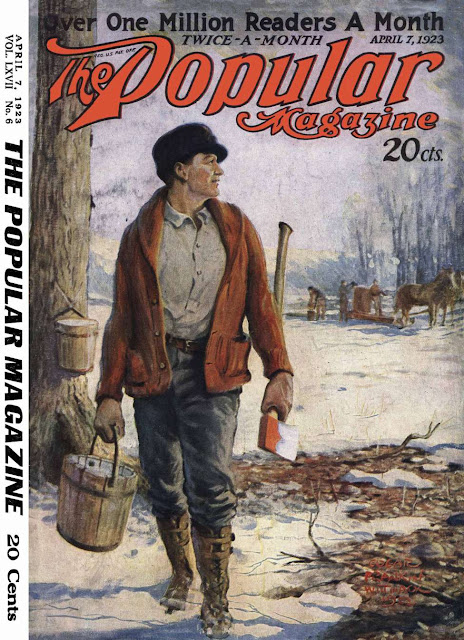"The Carlton Theater Mystery."
By Ralph Durand (1876-1945).
First appearance: The Popular Magazine, April 7, 1923.
Short short story (7 pages).
Online at Comic Book Plus (HERE; using dropdown menu select page 162).
"But this business—this is murder."
Sherlock Holmes was known to blur the line between the strictures of the law and the imperatives of justice and would sometimes let things slide. In today's story, an amateur detective faces the same dilemma, because he knows that the killer did it for what many would consider to be the best of reasons. Nevertheless, he feels compelled to ask: "Is
murder ever justifiable?"
Main characters:
~ Irene St. George, the corpus delicti:
"Fell dead on the stage, she did, and the doctor said she was poisoned."
~ Detective Simmonds, the long arm of the law:
". . . resented being set a task that was outside his own special line. Burglary was his department."
~ Albert Mayo, "the famous ex-burglar revivalist preacher":
". . . was too often inclined to show a warm fellow feeling for the criminal and could never be trusted not to help him escape instead of handing him over to justice."
~ Talesa, the Belle of Tahiti:
". . . used to be a star at the Carlton . . ."
~ Doctor Aubrey Buxton:
". . . said that she was poisoned and that all the symptoms pointed to its being a rare poison called curare."
~ Tom Parker:
"Asked if he knew of any one who had any reason to have a grudge against Miss Irene St. George, her manager, Mr. Tom Parker, frankly admitted that he knew of scores."
~ The editor of the Sentinel:
"I won't say anything about the woman because convention demands that one must not speak ill of the dead until after the lapse of a certain amount of time."
~ The gunshop owner:
"An air gun or air pistol . . ."
References and resources:
- We get a brief tour of some of London's landmarks:
"Scotland Yard" (HERE) - "Blackfriars" (HERE) - "Trafalgar Square" (HERE) - "Chiswick" (HERE) - "Whitehall" (HERE) - and "Charing Cross" (HERE).
- "Doss houses":
Americans have a different name for the same thing: "A flophouse (American English) or dosshouse (British English) is a place that offers very low-cost lodging, providing space to sleep and minimal amenities." (See Wikipedia HERE.)
- "a single humming bird will destroy many hundreds of noxious insects":
This is true: "Hummingbirds are famous for drinking nectar out of flowers. They're nature's sugar addicts. But they don't live on nectar alone. Hummingbirds eat insects to add proteins and minerals to their diets. They may pick these insects off leaves and trees (a process called 'gleaning'). They're also skilled enough fliers to catch fruit flies and other small bugs in midair (which is called 'hawking')." (See Ask a Biologist HERE.)
- "Millions of acres won from the forest by man's toil are returning to forest again through man's greed and stupidity":
How many citizens of the 21st century would regard that statement with equanimity?
- "Osprey plumes are obtained from the egret":
"So-called 'osprey' plumes were an important item in the plume trade of the late 19th century and used in hats including those used as part of the army uniform. Despite their name, these plumes were actually obtained from egrets." (See Wikipedia HERE and HERE.)
- This was not Albert Mayo's only appearance. We've had to make a few guesses, so what follows might not be fully accurate (FictionMags data):
(1) "Set a Thief—," The Popular Magazine, December 7, 1922
(2) "The Mallard Diamond Case," The Popular Magazine, December 20, 1922
(3) "The Plundering of Mr. Potts," The Popular Magazine, March 20, 1923
(4) "The Carlton Theater Mystery," The Popular Magazine, April 7, 1923 (above)
(5) "The Cocaine Smuggler," The Popular Magazine, April 20, 1923 (reprinted from The Detective Magazine, December 22, 1922)
(6) "Mayo’s Last Case," The Popular Magazine, May 7, 1923.
- FictionMags' thumbnail about Ralph Anthony Durand: "Librarian and museum curator, world traveler, author of novels, short stories and reference works." Durand's series character was Peter Darrell, featuring continuously in 8 stories in The Windsor Magazine from June 1927 to January 1928.
Unless otherwise noted, all bibliographical data are derived from The FictionMags Index created by William G. Contento & edited by Phil Stephensen-Payne.
~~~~~~~~~~~~~~~~~~~~~~~~~~~~~~~~~~~~~~~~~~~~~~~~~~~~~~~~~~~~~~~~~~~~~~~~~~~~

.jpeg)




No comments:
Post a Comment